Join us for breakfast on the beach of Water’s Edge: Africa. Animal keeper, Al, is feeding our flock of 11 African penguins while she tells us about their personalities – and how you can identify each penguin.
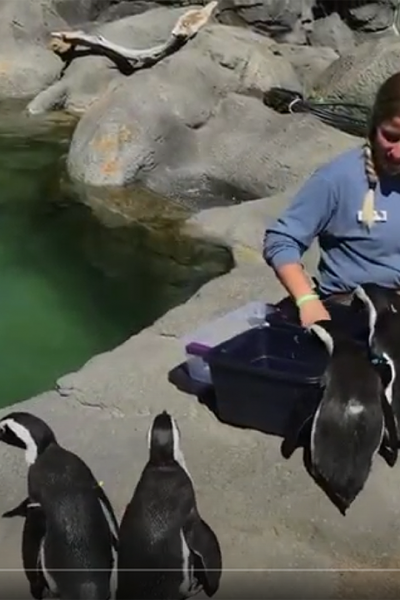

Join us for breakfast on the beach of Water’s Edge: Africa. Animal keeper, Al, is feeding our flock of 11 African penguins while she tells us about their personalities – and how you can identify each penguin.
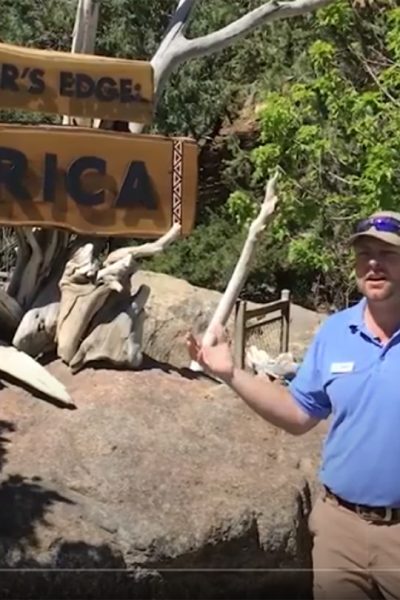

Meet some of the keepers, see some of the animals and learn about some of the cool features of our newest exhibit for hippos and penguins – Water’s Edge: Africa!
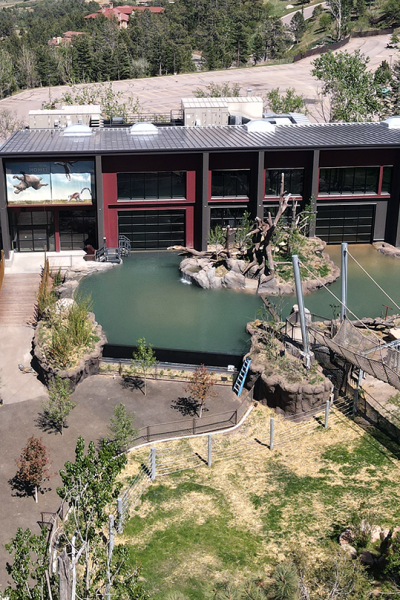

Saturday, May 23, 2020 (COLORADO SPRINGS, Colo.) – With Water’s Edge: Africa Construction Issues Resolved, Nile Hippos Return to CMZoo! The sounds of hippo ‘laughs’ are once again echoing from the side of Cheyenne Mountain. Zambezi (zam-BEE-zee) and Kasai (kuh-SIGH), CMZoo’s Nile hippo sisters, are back home at Cheyenne Mountain Zoo!
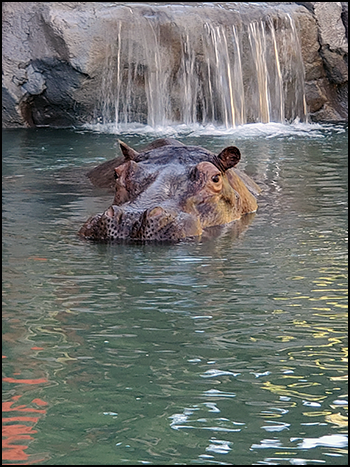
The two female hippos have been ‘vacationing’ at Dickerson Park Zoo, an Association of Zoos and Aquariums-accredited zoo in Springfield, Missouri, since October 2016, when construction began on Water’s Edge: Africa. Zambezi, 27, originally came to Cheyenne Mountain Zoo in 1993. Kasai, 20, originally came to CMZoo in 2001. Given their long-time residence and personable demeanors, the girls are well-loved by staff, the community and CMZoo fans all around the world.
“The question of the year has definitely been, ‘When are the hippos coming back?’ We’re just so happy the girls are finally home,” said Patty Wallace, senior lead keeper at Water’s Edge: Africa, the new home for hippos, penguins, warthogs, lemurs and more, at CMZoo. “There were a lot of happy human tears and a lot of wiggling hippo ears on Friday morning, as we watched them explore their new home. It’s so fulfilling to see them enjoying this beautiful space and settling back in. We missed them!”
The hippos’ 750-mile journey home wasn’t your average road trip. Preparing to transport the girls, who each weigh over 3,000 pounds, required months of preparation, skilled staff and transport professionals, and specialized machinery and equipment. Three CMZoo staff members drove to Dickerson Park Zoo to help the hippos transition and bring them home. The team consisted of Wallace; Jeremy Dillon, Water’s Edge: Africa Animal Care Manager; and Dr. Liza Dadone, a veterinarian and the Zoo’s Vice President of Mission and Programs.
“This isn’t their first road trip, but it’s been three and a half years since their last transport, so we don’t make any assumptions about how smoothly things will go,” said Dillon. “Transporting nearly four tons of hippopotamus is risky, no matter how many times you’ve done it. Since they arrived at Dickerson Park Zoo, back in 2016, they’ve been preparing for this trip home – and so have we.”
Making sure Zambezi and Kasai are comfortable and confident during their transport is vital to keeping them from getting too stressed or injuring themselves. The hippos are trained to be comfortable in their crates during a transport, which means they are awake for the entire transfer.
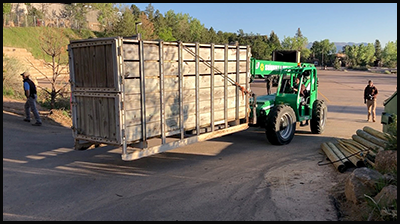
The steel-framed wooden crates were positioned as ‘hallways’ at Dickerson Park Zoo, so the hippos would pass through them daily when they went out into their yard. That meant they became familiar with the space and gained confidence being inside the crates. Through positive reinforcement, the girls became comfortable standing in the crate with only one end open, and eventually standing in their crates with both doors closed.
Thursday afternoon, the girls entered their separate crates, which were crane lifted out of their exhibit space and then lifted by forklift into a climate-controlled 72-foot semi-truck. After 12 hours of highway driving, with stops to check on the girls every two hours, the team arrived at Cheyenne Mountain Zoo around 5 a.m. Friday, May 22. From the Zoo’s public parking lot, the hippos were lifted one at a time, in their crates, by forklift and carried up to their new home.
“The transport really couldn’t have gone any better,” said Dillon. “Watching them come out of their crates, healthy and curious to explore their new home was awesome. I just wish we could share this experience with the public right away.”
Under current restrictions, the Zoo is temporarily closed to the public until further notice. But, when the Zoo is allowed to reopen, guests will be able to see the girls from one-of-a-kind perspectives, like the Water’s Edge: Africa giant rope bridge that hangs 8 feet above the outdoor hippo yard.
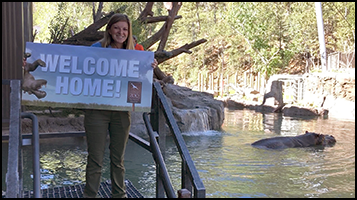
“I can’t wait for people to come and see Water’s Edge,” said Grace Vining, animal keeper. “It’s like an educational nature playground for animal lovers.”
Nature play was central to the design of Water’s Edge: Africa, so it features a nature trail with obstacles, like vertical logs to climb on and small boulders to hop, that leads to a huge rope bridge and ends at a platform overlooking the outdoor hippo pools and lemur island.
Cheyenne Mountain Zoo is known for providing interactive experiences with animals, and guests can expect that same level of engagement with animals at Water’s Edge: Africa. As many barriers between guests and animals have been removed as possible. A knife-edge hippo pool brings guests eye-to-eye with the hippos, as they bounce on a sand bar in their outdoor pool. Hippo lovers might even feel a splash or two, as the hippos make waves that flow over the exhibit’s many waterfalls. Guests are likely to leave the exhibit with wet feet, too, thanks to an ‘ocean surge’ from the outdoor penguin pool that splashes onto guest viewing areas. That surge isn’t the only thing guests will want to look down for – the outdoor penguin area is designed so penguins have the opportunity to walk right up to guests if they want to.
Eleven African penguins arrived at Water’s Edge: Africa at the end of April. Nine more will be joining the flock as soon as possible. In addition to African penguins and Nile hippos, ring-tailed lemurs and common warthogs will make homes at the brand-new exhibit, as well as a few other species.
Only 30 organizations accredited by the Association of Zoos and Aquariums in North America house hippos. The International Union for Conservation of Nature (IUCN) Red List categorizes Nile hippopotamuses as a species vulnerable to extinction in the wild, estimating 125,000 to 150,000 remain in their native habitats. The primary threats are habitat loss and illegal and unregulated hunting. Hippos are hunted for ivory, which is found in hippopotamuses’ canine teeth, and for food.
Cheyenne Mountain Zoological Society was founded in 1926. Today, Cheyenne Mountain Zoo, America’s mountain Zoo, offers comprehensive education programs, exciting conservation efforts and truly fantastic animal experiences. In 2019, Cheyenne Mountain Zoo was voted #6 Best Zoo in North America and CMZoo’s Rocky Mountain Wild was named #5 Best Zoo Exhibit in North America by USA TODAY 10Best Readers’ Choice Awards. It is Cheyenne Mountain Zoo’s goal to help guests fall in love with animals and nature, and take action to protect them. Of the 233 zoos and aquariums accredited by the Association of Zoos and Aquariums (AZA), Cheyenne Mountain Zoo is one of just a few operating without tax support. Cheyenne Mountain Zoo depends on admissions, membership dues, special event attendance and donations for funding.
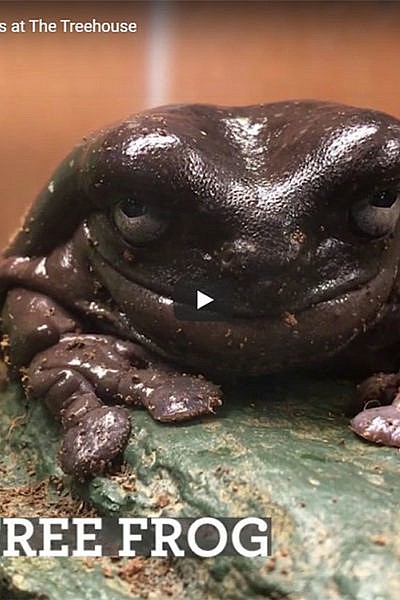

There’s a magical – but little known to some – place at Cheyenne Mountain Zoo where axolotls, tarantulas, millipedes and more live! Get to know the residents at The Treehouse in My Big Backyard.
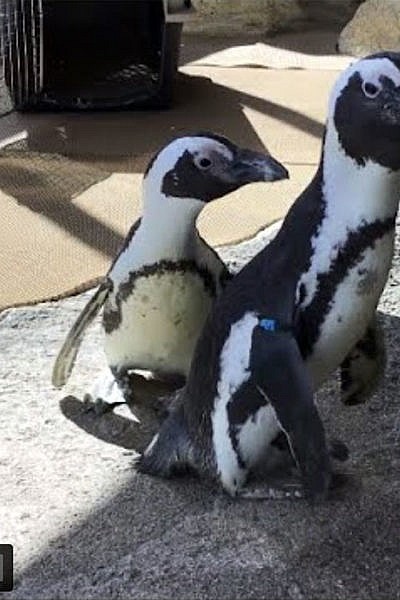

We have BIG NEWS on #WorldPenguinDay! Our first five African penguins have arrived! Since our temporary closure, we’ve continued work on Water’s Edge: Africa, our new home for hippos, penguins, warthogs, lemurs and more. We’re happy to report the new exhibit’s first residents are settling in.
In this video, meet CMZoo African penguins Pomona, Safara, Alex, Rudo and Rufaro! You’ll also see a behind-the-scenes sneak peek at their medical checks, their first dip in the indoor pool and their first time taking in the beautiful views from the mountainside. You’re also getting the first public glimpse at the penguin pools in all their leakless glory!
The issues with the hippo pools haven’t been resolved yet, but we’re continuing work on them and will keep you posted on any hippo-sized news. We can’t wait to have you all back to meet the penguins in person!
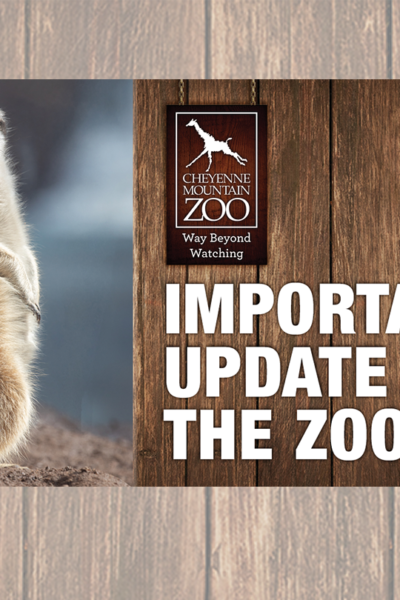

UPDATE: Cheyenne Mountain Zoo’s reopening date has been changed from April 1, 2020 to April 17, 2020. This is an update to the Zoo’s official statement from March 16, 2020, which you can find below.
(Colorado Springs, Colo.) – At Cheyenne Mountain Zoo, we believe we have multiple responsibilities to our community, in addition to our responsibilities to the natural world. Our unique atmosphere allows friends and family to spend quality time together, while providing our guests an opportunity to spend time in the outdoors, which has been shown to improve both physical and mental well-being. All of these were reasons that Cheyenne Mountain Zoo remained open to the public through today.
While we had support from city and county government officials to remain open with our already strong precautionary measures, the time has come to support our country’s decision makers and unite behind a common goal. Cheyenne Mountain Zoo is announcing a temporary closure of its public operations in response to today’s request by President Donald Trump to join together to suppress the COVID-19 virus. The closure will be effective tomorrow (Tuesday, March 17, 2020), and we are already beginning to plan our reopening on April 1, 2020, assuming that the current 15-day guidance has not been extended. As soon as possible, we want to provide a beacon of hope for our community in this unusual time.
During the closure, the Zoo’s staff will keep busy, not only providing our excellent standard of care for our animals, but also with other important work around the Zoo. The closure will provide Zoo staff with the opportunity to continue to prepare for Association of Zoos and Aquariums accreditation inspections scheduled for this summer, which is something that happens once every five years. Staff will also focus on detailed preparations for the opening of the Zoo’s new hippo and African penguin exhibit, Water’s Edge: Africa, which we hope will open sometime in May. We are thankful to be able to keep all of our Zoo family employed through the 15-day closure.
All public EdVenture programs originally scheduled through March 31, 2020 are canceled or will be rescheduled, including Spring Break Camp, Stroller Safaris, WildNights, ZOOMobile outreach programs, birthday parties and any other public programs. Please email [email protected] or call (719) 424-7827 for information about refunds or other questions.
While the Zoo is closed, the public is encouraged to stay virtually connected to our animals through our social media channels and website. On nice days, fans of our giraffe herd will continue to be able to watch the herd shift into their outdoor yard via the Zoo’s YouTube channel or at cmzoo.org/giraffecam. Zoo staff also will also continue to provide updates on our animals through our social media feeds: Facebook, Instagram, Twitter and YouTube.
Any further updates on the status of the Zoo’s closure will be updated via the green “alert” message on our home page at cmzoo.org.
Cheyenne Mountain Zoological Society was founded in 1926. Today, Cheyenne Mountain Zoo, America’s mountain Zoo, offers comprehensive education programs, exciting conservation efforts and truly fantastic animal experiences. In 2019, Cheyenne Mountain Zoo was voted #6 Best Zoo in North America and CMZoo’s Rocky Mountain Wild was named #5 Best Zoo Exhibit in North America by USA TODAY 10Best Readers’ Choice Awards. It is Cheyenne Mountain Zoo’s goal to help guests fall in love with animals and nature, and take action to protect them. Of the 233 zoos and aquariums accredited by the Association of Zoos and Aquariums (AZA), Cheyenne Mountain Zoo is one of just a few operating without tax support. Cheyenne Mountain Zoo depends on admissions, membership dues, special event attendance and donations for funding.
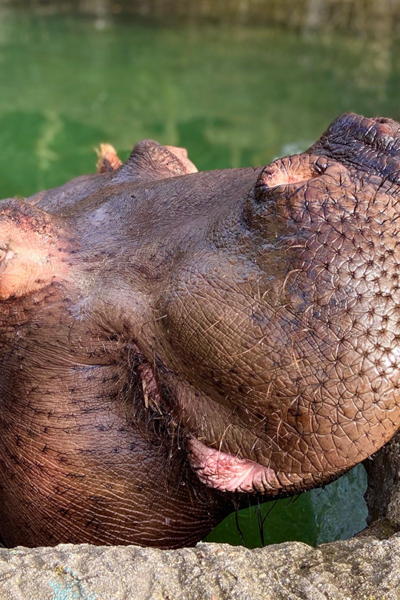

Although Water’s Edge: Africa’s opening date hasn’t been set, Cheyenne Mountain Zoo is steadily preparing to welcome home Zambezi (zam-BEE-zee) and Kasai (kuh-SIGH), two female Nile hippopotamuses who are taking an extended vacation at Dickerson Park Zoo, in Springfield, Missouri. They moved there in 2016 to allow us to build a new state-of-the-art exhibit for them.
Patty Wallace, Water’s Edge: Africa lead animal keeper, worked with Zambezi and Kasai for six years at Cheyenne Mountain Zoo. Wallace spent five of those years as their primary trainer. She is excited for guests to get to know the girls again and to see them in their brand-new home.
Kasai is 20 years old and larger than her older sister, Zambezi. Kasai is easily identifiable by the pink spots on the tops of all four of her feet. Zambezi is 27 years old and has a more consistent skin tone than Kasai. Both hippos enjoy participating in training, but Kasai tends to have a more dominant personality, which often means she’s the first to investigate new enrichment or food.
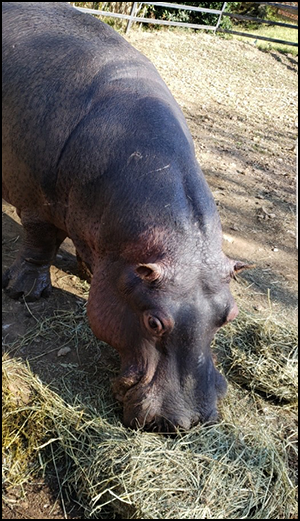
“I’m really excited about rekindling our relationship and getting to know the hippos again,” said Wallace. “We can expect them to be a little cautious coming into this new building, because they’ve never been there before. Part of the challenge is getting them back to the level of comfort they had before. They’re both really food motivated, so I expect it will take a lot of patience, understanding and watermelon to help the girls gain confidence in their new space and with keepers again.”
Only 30 organizations accredited by the Association of Zoos and Aquariums in North America house hippos. In addition to their somewhat rare presence in zoos, Wallace says part of the CMZoo hippos’ appeal is their generally calm and gentle demeanors.
“Hippos are known as one of the most dangerous animals in the world, with incredibly impressive strength and size,” said Wallace. “Zambezi and Kasai have grown up in human care, so they’re used to people. They may scuffle with each other from time to time, but they really are gentle giants.”
A big part of helping the hippos gain confidence in their new home is training the keepers to control the myriad of new building features that will help them care for Zambezi and Kasai. Keepers are getting accustomed to underwater shift doors, hydraulic doors, garage doors, cable-and-bollard systems, water filtration systems, heating and cooling systems, lighting, behind-the-scenes kitchen and enrichment preparation areas, and more.
“We’re also planning our animal demonstrations and enrichment activities, considering how the girls might like to interact with us in this space and what will give our guests a memorable experience,” said Wallace. “We have a ton of opportunities to help guests fall in love with hippos, thanks to the design of this awesome new space.”
Water’s Edge: Africa’s indoor hippo demo space allows guests to get right up close to the hippos, with only bollards in between them and the animals. In the same area, guests can stand on a scale that helps them see how many humans it takes to weigh the same as a hippo. Near the outdoor hippo yard, a nature trail takes guests to a rope bridge that hangs above the hippo yard, giving guests a first-time bird’s eye view of the girls in water and on land. A knife-edge outdoor pool will help guests see the hippos as the hippos see them – just above the water line.
“You can be eye-level with a basking hippo at the knife-edge pool’s viewing area,” said Wallace. “It is going to be such a cool experience. I can’t wait for everyone to visit the new exhibit and hopefully form long-lasting relationships with these beautiful girls.”
At Dickerson Park Zoo, keepers are working with the girls to make them as comfortable as possible for their trip home to CMZoo, including building the hippos’ comfort level with their transport crates.
“We situated their transport crates so they’re part of the entrance to their yard, which allows them to travel through them and be around them regularly,” said Tracy Campbell, senior zookeeper at Dickerson Park Zoo. Campbell has worked with the girls since they arrived in 2016 and has worked with hippos for 20 years. “Once we have an exact timeline for their trip back to Cheyenne Mountain Zoo, we’ll increase their crate training time, but for now we’re keeping them acclimated by walking through them.”
Wallace was part of the transport training when the girls first traveled to Springfield.
“We trained with them for about three months before their last transport,” said Wallace. “They traveled in separate crates made of wood and steel. Like Dickerson Park Zoo is doing, we positioned the crates as entrances to the building, so they could walk through them and gain confidence with them over time. They were hesitant at first, but since they’re so food motivated, it didn’t take them long to get the hang of it.”
The trip between Dickerson Park Zoo and Cheyenne Mountain Zoo takes about 11 hours. The hippos travel in their crates inside an enclosed and climate-controlled flatbed truck. Once the hippos are comfortably in their crates, a large crane is used to move the 1.5-ton animals onto the truck. During the transport, the hippos are monitored to address any needs along the way. All went smoothly last time, and CMZoo keepers stayed with the girls at DPZ for about a week to help them settle in.
“I’m excited to have the girls home again,” said Wallace. “In the mornings, I would call ‘good morning, hippos!’ and they’d vocalize and poke up out of the water to look for me. They’d watch and wait for me to prepare their breakfast – and they’d let me know if I was being too slow. They’d walk up the ramp and stare at me, watching my every move. I can’t wait to see them and our guests exploring this amazing new exhibit.”
The International Union for Conservation of Nature (IUCN) Red List categorizes Nile hippopotamuses as a species vulnerable to extinction in the wild, estimating 125,000 to 150,000 remain in their native habitats. The primary threats are habitat loss and illegal and unregulated hunting. Hippos are hunted for ivory, which is found in hippopotamuses’ canine teeth, and meat.
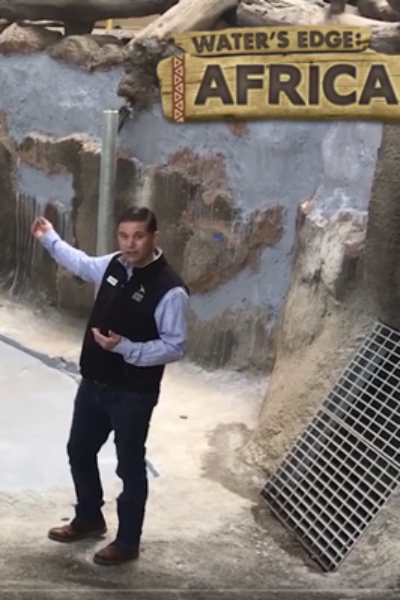

Bob Chastain, CMZoo president and CEO, is back with the latest update from Water’s Edge: Africa. We’ve refilled the void in the soil under the indoor hippo pool and waterproofed the new concrete. Soon, we’ll do another water test to measure continued water loss.
Get an up-close view of the micro cracks that we’re repairing with a filler product that has some elasticity. We hope the lining material we apply next will stop those leaks.
Also, in this video, we’re giving you a first-time sneak peek at the Water’s Edge: Africa vacation yard. This outdoor yard and pool will be used by a variety of animals and will be visible to guests on their way to Primate World.
Although we don’t yet have an opening date, we’re getting closer! We’re still aiming to begin introducing animals to the building sometime in March. We’ll keep you posted!
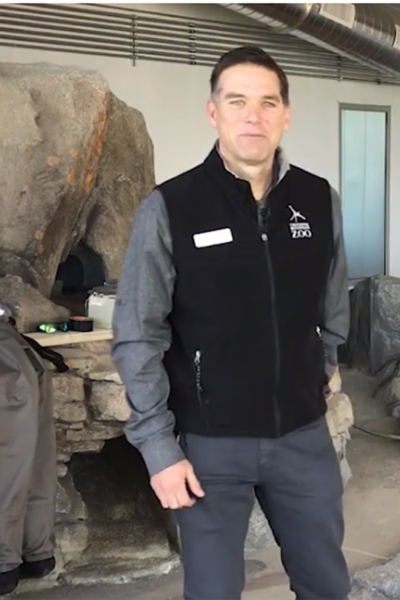

Bob Chastain, CMZoo president and CEO, is back with an update on Water’s Edge: Africa! From the indoor penguin pool, Bob gives the details about the pool and underground excavation, soil testing (good news!), and reconstruction of the hippo and penguin pools. The next step is additional water testing, which involves measuring how much the pools’ water levels are dropping overall, and establishing how much of that water is evaporating, rather than leaking. It’s a complicated process when you consider the intricacies of the pools, the indoor and outdoor elements and multiple surfaces.
Although we don’t yet have an opening date, we’re still looking at bringing hippos and penguins home as early as March, so stick with us. We’ll keep you posted as we progress through this next testing phase.
Thanks for your continued support!
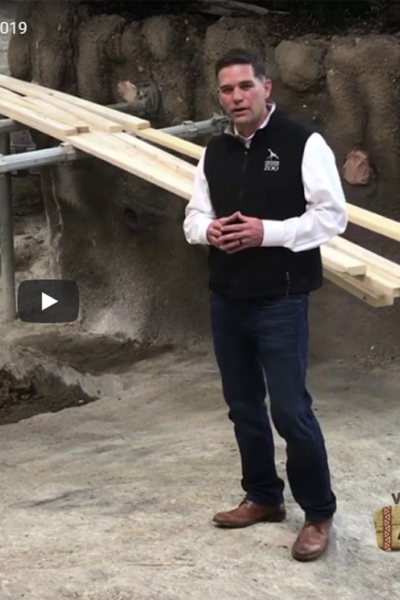

We’re back with an update on our hippo and penguin exhibit under construction, Water’s Edge: Africa. Bob Chastain, president and CEO of CMZoo, explains why we’re experiencing delays and gives the most recent anticipated opening timeline. We really wanted a hippopotamus for Christmas, but (#spoileralert) it’s going to be at least a few more months until we can welcome the hippo girls home.